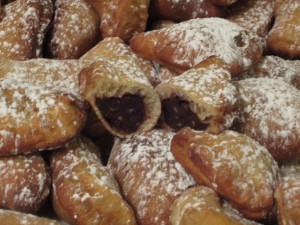 Growing up on the east coast, we always spent the Christmas holidays with my father’s family in Brooklyn. Driving up from DC the day after Christmas, we’d arrive in time to for dinner. The house was decorated and warm with lights and garland, every dinner was festive and dessert always included a big platter of fried pastry: struffoli sprinkled with tiny colored confection balls and long strips of crunchy dough drizzled with honey; but my grandmother’s specialty were her chestnut ravioli. Chestnuts come from her hometown of Montella, in the mountains of Campania just to the east of Naples, and she prided herself on this delicious Christmas specialty. Flavored with cocoa and various liquors, chiefly the southern Italian strong tasting Strega, it was never my favorite as a child, so I politely ate the chewy fried pastry around the filling and hid the dark, strong chestnut filling in a napkin.
Growing up on the east coast, we always spent the Christmas holidays with my father’s family in Brooklyn. Driving up from DC the day after Christmas, we’d arrive in time to for dinner. The house was decorated and warm with lights and garland, every dinner was festive and dessert always included a big platter of fried pastry: struffoli sprinkled with tiny colored confection balls and long strips of crunchy dough drizzled with honey; but my grandmother’s specialty were her chestnut ravioli. Chestnuts come from her hometown of Montella, in the mountains of Campania just to the east of Naples, and she prided herself on this delicious Christmas specialty. Flavored with cocoa and various liquors, chiefly the southern Italian strong tasting Strega, it was never my favorite as a child, so I politely ate the chewy fried pastry around the filling and hid the dark, strong chestnut filling in a napkin.
Luckily I grew up and learned to appreciate how luscious a little alcohol can make a simple filling of ground chestnuts, cocoa and sugar.
These are simple to make, beautiful to serve, piled high on a plate and drizzled with honey, and delicious to eat. Buon Natale!
Panzerotti (fried chestnut pastries)
Dough:
3 cups flour
3 tbsp sugar
2 teas baking powder
3 eggs
3 tbsp vegetable oil
2 tbsp milk
¼ cup brandy, Cointreau or Grand Marnier
Mix the dry ingredients together, add the wet ingredients into the center and mix thoroughly, adding additional flour if too sticky. Wrap and refrigerate for three hours.
Filling:
The base of the filling is chestnut, but if my grandmother couldn’t get enough or they were too expensive she mixed them with ceci, or chickpeas. You can either get fresh chestnuts and boil and peel them, or canned chestnuts, which definitely cuts down on time. If using canned or jarred nuts, make sure there is no sugar added, just chestnut.
The liquor that’s added is just enough to help the mix puree smoothly into a paste and can be a combination of anything you have, some sweet, some not.
3 cups chestnut meat
1 cup dark cocoa
1 cup sugar
1/8 teas cloves
¼ teas cinnamon
Zest from one orange
Liquors: Cointreau or triple sec, brandy, amaretto, anisette, Strega, rum
Take a small amount of the dough and roll it onto a floured surface. Cut 2 inch rounds with a cookie cutter, moisten the edges and place a large spoonful of the filling inside. Fold the panzerotti into a half moon shape and firmly secure the edges with the tines of a fork. Heat peanut oil to 350 degrees on a candy thermometer and fry the panzerotti in batches. Drain on paper towels. Dip in granulated sugar, sprinkle with powdered sugar, or drizzle with chestnut honey.











